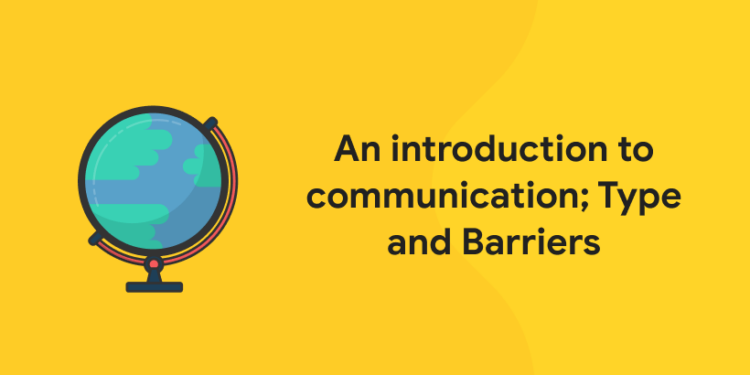Table of Contents
Well Communication is exchanging data or information between entities. Yeah! we can describe communication as it is the process of sharing or exchange of ideas, information, knowledge, attitude, or feeling among two or more persons through certain signs and symbols. The importance of effective communication is immeasurable in the world of business and in personal life.
Communication, in simple words, is the transmission of a message or idea from the sender to the receiver. The sender may be a person or a group of persons, who transfer thoughts or ideas to a destination. The destination may also be an individual or group that receives the messages.
Introduction to Communication
Definition
Communication is the process of transmitting information from sender to receiver. Communication is the act of sharing of ideas, facts, opinions, thoughts, messages to other people, in and out the organisation, with the use of the channel to create mutual understanding and confidence.
For communication to take place a sender/encoder comes up with the message and sends it through a medium/channel to the receiver/decoder who decodes and processes the information before giving feedback, again through a medium.
- Exchange of ideas and information
- Drafting of proposals and plans
- Communicating and execution of decisions
- Receiving and processing orders
Elements of Communication
Communication is a two way process, wherein interchange of information connects the sender and receiver and both ends. All the elements of communication has a great role to play in the entire process of transmitting data.
Sender: Otherwise known as a source, it is the person who has something to pass on, to another individual.
Encoding: The sender of the message, selects appropriate words or non-verbal techniques to convert the idea into the message, which is called as encoding.
Message: Message implies something that the sender wants to communicate, to the receiver. Without a message, no communication is possible.
Medium: Medium alludes to the channel or mode, through which message is communicated to the receiver, i.e. it can be sent by way of electronic word processing system, graphic, symbol, etc.
Receiver: The one to whom the message is directed, is called receiver. He/she notices and conveys some meaning to the message.
Decoding: The act of interpreting message by the receiver, is termed as decoding. The receiver’s outlook, experience, and attitude play a vital role in decoding message.
Feedback: The process of communication can never be completed, if the response of the receiver is missing. It enables the communicator of a message to know whether the message has been received and interpreted in the same manner as directed.
Attempt Free GK Mock test ! Download Entri App!
Types of Communication
1: Which of the sentences below is grammatically correct?
Communication can be basically categorized into three types:
(1) Verbal communication, in which you listen to a person to understand their meaning.
(2) Written communication, in which you read their meaning.
(3) Nonverbal communication, in which you observe a person and infer meaning.
Verbal communication
This mode of communication relies on words to convey a message. This is the standard method of communicating that most of us use on a day-to-day basis, though we rarely use it without augmenting it with one of the other communication types. Other cues people use while communicating verbally include, tone, gestures, and body language. Verbal communication helps in expressing thoughts, emotions and sentiments. A phone conversation, chat with a friend, an announcement made, or a speech delivered are all verbal forms of communication.
Verbal communication is further divided into four subcategories:
1. Intrapersonal Communication
This form of communication is extremely private and restricted to ourselves. It includes the silent conversations we have with ourselves, wherein we juggle roles between the sender and receiver who are processing our thoughts and actions. This process of communication when analyzed can either be conveyed verbally to someone or stay confined as thoughts.
2. Interpersonal Communication
This form of communication takes place between two individuals and is thus a one-on-one conversation. Here, the two individuals involved will swap their roles of sender and receiver in order to communicate in a clearer manner.
3. Small Group Communication
This type of communication can take place only when there are more than two people involved. Here the number of people will be small enough to allow each participant to interact and converse with the rest. Press conferences, board meetings, and team meetings are examples of group communication. Unless a specific issue is being discussed, small group discussions can become chaotic and difficult to interpret by everybody. This lag in understanding information completely can result in miscommunication.
4. Public Communication
This type of communication takes place when one individual addresses a large gathering of people. Election campaigns and public speeches are example of this type of communication. In such cases, there is usually a single sender of information and several receivers who are being addressed.
Grab Study Materials to Strengthen your Knowledge in GK!! Register Here!
Written communication
Written communication is the medium through which the message of the sender is conveyed with the help of written words. Letters, personal journals, e-mails, reports, articles, and memos are some forms of written communication. Unlike some other forms of communication, written messages can be edited and rectified before they are sent to the receiver, thereby making written communication an indispensable part of informal and formal communication. This form of communication encapsulates features of visual communication as well, especially when the messages are conveyed through electronic devices such as laptops, phones, and visual presentations that involve the use of text or words.
Nonverbal communication
Non-verbal communication is a process of communication without using words or sounds. Non-verbal communication uses gestures, body language, facial expressions, eye contact, clothing, tone of voice, and other cues to convey a message. Like verbal communication, this method of communicating is rarely used alone. Non-verbal communication could be considered like a spice we use when communicating to add a little flavor. You might raise your eyebrows emphatically when speaking to help make a point, or shake your finger at your child when you’re angry. These are all non-verbal cues that help convey a message.
Visual Communication
This form of communication involves the visual display of information, wherein the message is understood or expressed with the help of visual aids. For example, topography, photography, signs, symbols, maps, colors, posters, banners and designs help the viewer understand the message visually. Movies and plays, television shows and video clips are all electronic form of visual communication. Visual communication also involves the transfer of information in the form of text, which is received through an electronic medium such as a computer, phone, etc. Icons and emoticons are a form of visual communication. When these icons are used in a public place, phone or computer, they instruct the user about their meaning and usage. One of the greatest examples of visual communication is the internet, which communicates with the masses using a combination of text, design, links, images, and color. All of these visual features require us to view the screen in order to understand the message being conveyed.
Attempt Free GK Mock test ! Download Entri App!
Spoken English Course for Guaranteed Confidence and Career Growth
Spoken English Course by Entri App: Enhance your communication skills, gain certification, and boost your career with confidence.
Join Now!Barriers of Communication
Communication barriers refer to factors that affect the effectiveness of the communication process. These factors create an obstruction in the flow of information between sender and receiver during communication. Barriers in communication lead to misunderstanding of message among sender and receiver. It becomes difficult to interpret the message correctly leading to a complete failure of communication due to these barriers.
Language Barriers
Language is one of the main barriers to the communication barrier. It is important that all persons involved in the communication process should clearly understand the language used. Language barriers arise when people are not able to understand the language used in communication as different people have different linguistic skills.
Sometimes these barriers arise during encoding and decoding of the message into words. Use of inappropriate words, different interpretations and faulty translations during the encoding-decoding process leads to miscommunication among persons.
Psychological Barriers
The psychological and emotional factors of persons affect the communication process. It is essential that both sender and receiver should be mentally fit and of sound mind while communicating with each other.
Speech disorders, depression, phobia, emotional IQ of persons are very difficult to manage and will affect the ease of communication process. It is important that a person communicating with each other should be emotionally mature.
Attempt Free GK Mock test ! Download Entri App!
Physical Barrier
Physical barriers arise due to noises, faulty equipment, closed doors, closed cabins while communication process. Geographical distance between the sender and receiver in the communication process creates a physical barrier.
Communication is easy when the distance between them is shorter as more channels are available. Modern technology and appropriate communication channels can help to avoid these barriers.
Attitudinal Barrier
Attitudinal barriers are values, attitudes, perceptions and attitudes of people that affect the communication. Problems with organisation staff, poor management, resistance to change and lack of motivation among the people are factors which affect communication effectiveness.
Sender and receiver personal factors become barriers to communicating. Superior may think that his authority might be adversely affected by particular communication and therefore he might suppress such communication. Superiors will not ask for their subordinates advice they don’t have confidence in their competency.
Cultural Barrier
People with different cultures and regions have different beliefs, values, beliefs and perceptions as per their cultures. Different cultures have different meaning for society basic values like dressing, religion, drink, food and general behaviour.
Therefore, it is quite important to take these cultural in differences into account while communicating with each other. To overcome the barriers to communication arising due to culture, empathy is important. Empathy is simply sensing people’s feelings and attitude to understand their cultural beliefs.
Environmental Barrier
Environmental barriers include certain environmental factors that affect the effectiveness of communication. Only peoples are not responsible for barriers to communication. Many environmental factors like situation or physical setting where communication takes place may lead to blocking of messages in the communication process.
It should ensure that an environment where communication is taking place should be comfortable and secure. It should not distract the communicators. Communicators should feel safe and be happy in the environment while listening and giving their suggestion.
Grab Study Materials to Strengthen your Knowledge in GK!! Register Here!
How to Overcome Barriers to Effective Communication?
Following are the different measures to overcome effective communication:
Ideas should be Clear before Communication
The person sending the message should have clear ideas in his mind about what he wants to convey. He should know the objective of the message and accordingly, he should arrange his thoughts in a systematized way.
Sender should Communicate According to the Receiver’s Needs
The sender should frame the structure of the message not according to his own level or ability but should keep in mind the level, understanding, and environment of the receiver.
Consult Others before Communication
During Communication planning, suggestions should be invited from all the concerned persons. Its main benefit is that all those people who are involved in the communication planning will contribute to the success of the communication system.
Be Aware of the Tone, Content, and Language of the Message
The sender should consider that the message should be transmitted in a clear, precise, and easy language. The tone of the message should not hurt the feeling of the receiver. Hence, try to formulate the content of the message in brief and ensure to avoid technical words.
Convey Things that is Helpful to Listener
The content of the message should be helpful and valuable to the receiver. The need and interest of the receiver should be kept in mind before communicating. Communication becomes more effective in such situations.
Ensure to getting Proper Feedback
The aim of getting feedback is to find whether the receiver has properly understood the meaning of the message received. While communicating face to face, the reaction on the face of the receiver can be easily understood.
Message should be Consistent
The message sent to the receiver should not be inconsistent. The information transferred should be in accordance with the objective, programs, policies, and techniques of the organization. When a new message is sent in place of the old message, a sender should always mention it as it will create confusion.
Follow Up Communication
To make the communication effective, the manager should attempt to know the weakness of the communication system. In this condition, effort should be made to know whether it is appropriate to focus more on formal communication or informal communication.
Be a Good Listener
Both sender and receiver must be good listeners in the communication process. Both should understand each other’s points of view with patience, attention, and a positive attitude. A receiver can receive much relevant information if he is a good listener.
Conclusion
Attempt Free GK Mock test ! Download Entri App!
Download Entri App, Entri provides you effective learnings in a period of time with the help of expert teams and you can accomplish the goal with the Entri App. Start your preparation for your dream government job with Entri App. We provide a wide range of courses over different government exams. We are providing you the best platform for the preparations for every prestigious exam. Here you can get access to a number of mock tests and get daily practice GK and Current affairs questions.
For candidates preparing for competitive exams like Bank Exam, UPSC exam and other Government Exams. Static GK connotes general knowledge about the static facts, the facts that are never going to change in the future. Entri App provides you with the best knowledge in GK and coaches candidates on different exams in your local language.












